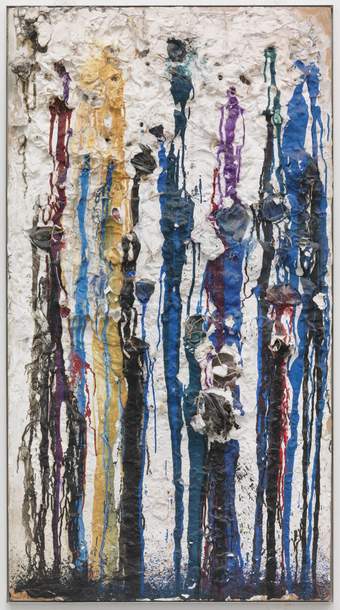A tour of Niki de Saint Phalle's first major UK exhibition. Beautiful, flamboyant, daring, provocative and fiercely independent, she emerged in the 1960s as a powerful and original figure in the highly masculine international arts world.
The exhibition included her acclaimed Shooting Pictures, made by firing a .22 rifle into bags of paint strapped to a canvas, as well as her brightly coloured, exuberant sculptures of enormous women, which she christened the 'Nanas'.
I’m Kyla McDonald and I’m assisting curator at Tate Liverpool, and we’re currently in the Niki de Saint Phalle Exhibition which is just opening. This is the first major Niki de Saint Phalle exhibition in the UK since her death in 2002, and it’s really the most major comprehensive survey of her work, going through the five decades of her career and showing all the different phases and changes that she made in her work. We start off the exhibition with her very, very early paintings, some of the ones that she did right at the beginning, where she was actually recovering from a nervous breakdown, and we get these very highly decorative, colourful paintings. These then developed into these assemblages where she started sort of paring down the decorativeness into abstract landscapes, but adding all these elements that she found around the house. So she started embedding broken plates and plastic toys that she found around, and she embedded these into the landscapes to make these sort of assemblages. And then we go slightly onto the more sinister, and she starts adding these violent elements to her work, like knives and guns. And it’s at this point that we see this dark element of Niki coming out. She’s sort of a very tortured soul, and she’s looking back again to perhaps this nervous breakdown that she’s had, and the way of her dealing with the complex emotions that she was feeling at the time. The Auto Portrait has sometimes also been called a ‘tortured self-portrait’, and it’s influenced, I think, by Gaudi as well, because obviously you’ve got the ceramic tiles in it, and she’d just recently visited Park Guell in Barcelona. However, it’s also looking at her own self, at her being tortured and tormented at that time, and the personal feelings that she was feeling in her head. So it’s a very sort of stark figure standing like alone, made out of all these assemblaged objects which she’s found around the house. I think the shooting paintings are very cathartic. They are a way of her sort of getting at her aggression by a very aggressive means. She would make little pockets of paint in plastic bags, and she would fill them with foodstuffs sometimes, and paints and all different kinds of things. She would then hang them on a wall in some way, and get a rifle and shoot at them. So these little pockets would burst open with paint, and you can see on all the paintings, they are very vibrant colours as the paint drips down the picture. She herself said that they were like making the paint ‘bleed’, so again it’s that process of shooting something and watching it die and bleed. After the shooting paintings, she has then gone through a quieter period, and wanted to move into exploring worlds of femininity, and women in society. So she looks at them from perhaps a negative point of view, looking at that women should only be brides or mothers. Perhaps it’s symptomatic of those feelings of entrapment that she had felt herself, because she creates these sort of grotesque sculptures which, even though they are very white and pure, and are covered with veils, they’ve got all sorts of dolls hanging from them, and crawling all over the bodies, and are very sort of monstrous and grotesque. And this is kind of opposed to then, at the same time, she starts making the Nana sculptures, which are very brightly coloured, exuberant sculptures of women, and they are very rounded, and these are sort of celebratory and triumphant femininity. So you’ve got these opposed two looks which are looking at more celebration, and sort of sad, despairing, grotesque. The Tarot Garden, which we concentrate on at the end of the exhibition, she had in the back of her mind that she always wanted to make a huge monumental outside garden that people could go and visit. She achieved that in 1999 when it opened, yet she worked 20 years to make that happen. And I feel that you get a sense, through this exhibition, that whatever she wanted to achieve, she achieved it in the end. Release date in this format: 04/02/2008 http://www.tate.org.uk/tateshots/episode.jsp?item=14121

